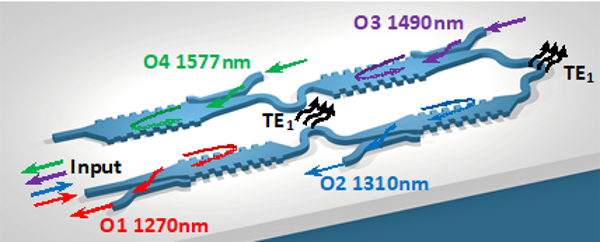A new round of scientific and technological revolution is on-going around the world, Internet technology and smart terminals are constantly developing. Especially after the outbreak of COVID-19 in 2020, emerging businesses such as online education, online office, and online medical services have developed rapidly. The role of the Internet as an infrastructure to support the development of human society has become increasingly prominent.
At present, the users' bandwidth demands continuously grow, and it is urgent to upgrade the existing access networks. As the mainstream broadband access technology, passive optical network (PON) is being upgraded from EPON/GPON to 10G PON. Meanwhile, note that GPON/EPON and 10G PON will coexist for a long time regarding the diversity of users.
Therefore, it is very desired and challenging to realize a smooth upgrade and evolution to a 10G PON without affecting the existing services. In order to solve this problem, a four-channel multiplexing architecture was proposed, including dual channels of 1310/1490 nm for GPON and dual channels of 1270/1577 nm for 10G GPON, in which way GPON can co-exist with 10G GPON smoothly.
In such an architecture, the core device is a quadplexer. Since a quadplexer is usually assembled with discrete components previously, the cost is high and the size is large, which is far from meeting the demands of transceiver chips. Therefore, it is urgent to develop on-chip quadplexers with excellent performances.
The challenge is that the wavelength span for the four-wavelength channels of 1310/1490/1270/1577 nm is extremely broad, while the channel spacing and the 3 dB-bandwidth are extremely nonuniform. It is very difficult to realize quadplexer by using those popular structures like arrayed-waveguide gratings (AWGs) and micro-ring resonators (MRRs).
Recently, the research group led by Professor Daoxin Dai from Zhejiang University proposed and realized the world's first on-chip quadplexer for PON systems, realized by using unique multimode waveguide grating filters in cascade, as shown in Fig. 1. The relevant results are published in Photonics Research, Vol. 9, Issue 5, 2021 (Dajian Liu, Long Zhang, Hexin Jiang, and Daoxin Dai, "First demonstration of an on-chip quadplexer for passive optical network systems," Photon. Res. 9, 757-763 (2021)).

Fig.1 The proposed silicon-based on-chip quadplexer.
The fabricated quadplexer has the desired bandwidths of ~20 nm, ~40 nm, ~20 nm, and ~5 nm for the channels of 1270/1310/1490/1577 nm, as required by the International Telecommunications Union standards. Furthermore, all channels have obtained flat-top spectral responses with low losses of <0.5 dB and low crosstalk of < −24 dB.
Professor Daoxin Dai said that the present quadplexer on silicon has outstanding advantages such as small footprints and high performances compared with traditional quadplexers assembled by discrete components. More importantly, it can be further integrated with the other components for realizing transceiver chips.


